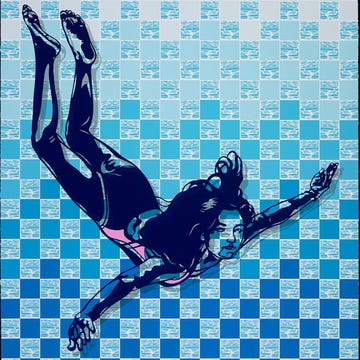By the time you read this, Mike Rogge will be unreachable. In June, Rogge proclaimed on LinkedIn that he’d be offline until August, since “it’s too nice outside to be on the internet all of the time.” This followed Rogge’s automatic out-of-office email reply in the spring that read, “My hope this year is to ski more. I intend to do that. Please allow a few days for a response.”
When he is reachable, usually at his desk near Lake Tahoe, where he lives with his family, Rogge serves as the owner, editor, and one-man cheer squad for Mountain Gazette, an outdoor lifestyle, sports, and culture magazine founded in 1966 that he acquired for $5,000 and a cold beer in 2020. (The handwritten bill of sale is featured prominently in a promotional video on the magazine’s Instagram feed.)
Since that time, Rogge has raised the profile of Mountain Gazette while also maintaining a rigorous ski schedule. He’s put out two huge issues per year (at 11 by 17 inches, Mountain Gazette dwarfs most publications, including the print version of Alta Journal); signed up contributors like actor Steve Martin, who writes an outdoor column illustrated by New Yorker cartoonist Harry Bliss; evangelized print media on podcasts like The Full-Bleed; received flattering coverage in Fast Company and the New York Times; and most astonishing for a print magazine in 2024, attracted readers who are willing to shell out $35 per issue for 200 pages of fresh mountain journalism.
That beer has really paid off.
“We want to surprise our readers,” Rogge says. “We’re not Chicken Soup for the Outdoor Soul.”
The first incarnation of the magazine, which was started by Mike Moore in Colorado as Skier’s Gazette and later took the name Mountain Gazette, was compared to the Village Voice because of its gonzo approach to outdoor journalism, which included pieces by and about Edward Abbey, Hunter S. Thompson, Gary Snyder, and others who put in their time at high altitudes even if they weren’t skiers per se. Mountain Gazette celebrated the “dirtbag lifestyle”—rough and ready outdoor exploration that put a premium on freedom over all else—before that life was commodified by brands or reduced to hashtags on Instagram.
Rogge’s vision for his version of the magazine falls in the non-commodified camp. Mountain Gazette is not a publication of gear reviews, listicles about the best slopes, and guides to haute après-ski attire. Full of essays, reported stories, full-bleed photo spreads, and humor pieces and printed on heavy bound paper at nearly IMAX scale, the magazine honors “dirtbags” while feeling like a premium object.
“I wanted a big canvas because I thought photographers deserve that,” Rogge says of his publication’s proportions. “I’ve known outdoor photographers and writers who have risked their lives or put themselves in great personal harm, or potential great personal harm, only to get a 400-word blurb in a magazine that’s on pretty bad paper.” The idea is to capture the bigness of the world on the page. A recurring visual motif on Mountain Gazette’s Instagram feed is of copies swallowing young readers up or sticking out on the newsstand like the tallest kid in a class photo.
Mountain Gazette’s size isn’t merely a gimmick: it’s a reminder that physical objects still hold appeal in our streaming, algorithm-dominated era. Rogge speaks enthusiastically of a cohort of young people raised online who nevertheless find themselves drawn to physical media—film cameras, books, vinyl records, print magazines—as an antidote to digital life. “I think the idea of something tangible that they could have and hold in their hand is really, really, really important to them,” he says.
Magazines like the Believer, Creem, McSweeney’s Quarterly Concern (which recently dropped its 25th-anniversary issue in an Art Spiegelman–designed lunchbox), and, yes, Alta are using high-quality paper stock, perfect binding, special inserts, and foldouts to make good on Marshall McLuhan’s oft-quoted axiom that the medium is the message. These are magazines for readers who care about stories and the pace at which they are told.
Rogge has no plans to increase his publication’s frequency or pursue scale for scale’s sake. “At this current size, we could stop growing entirely and I could live out the rest of my life very, very comfortably in Northern California and could pay our staff, could pay our contributors,” he says.
In addition to putting out Mountain Gazette and generating a steady drumbeat of publicity on social media, Rogge is at work on a book. He also keeps more than busy with his young family, but, as those out-of-office messages make clear, he finds plenty of time to enjoy his life.
The office he and his wife work out of is next to Bear Belly Brewing Company in Kings Beach, the perfect place for Rogge to hang with his friend, “nano”-brewmaster Adam Latham, as they both work on their small-batch projects. “I just sit there and have an 11 a.m. beer and write a piece,” Rogge says. “When I started this, I wanted to put out two good print magazines a year and ski a hundred days, and I get to do that.”•
Matt Haber is a freelance journalist. He has worked as an editor at Alta Journal, the Village Voice, the New York Observer, and the Atlantic. Most recently, he served as the San Francisco bureau chief for Inc. His writing has appeared in the New York Times, the San Francisco Chronicle, New York, Los Angeles, and other publications. He also co-created and co-edits Creative Growth Magazine, an annual arts publication put out by Oakland’s Creative Growth.












